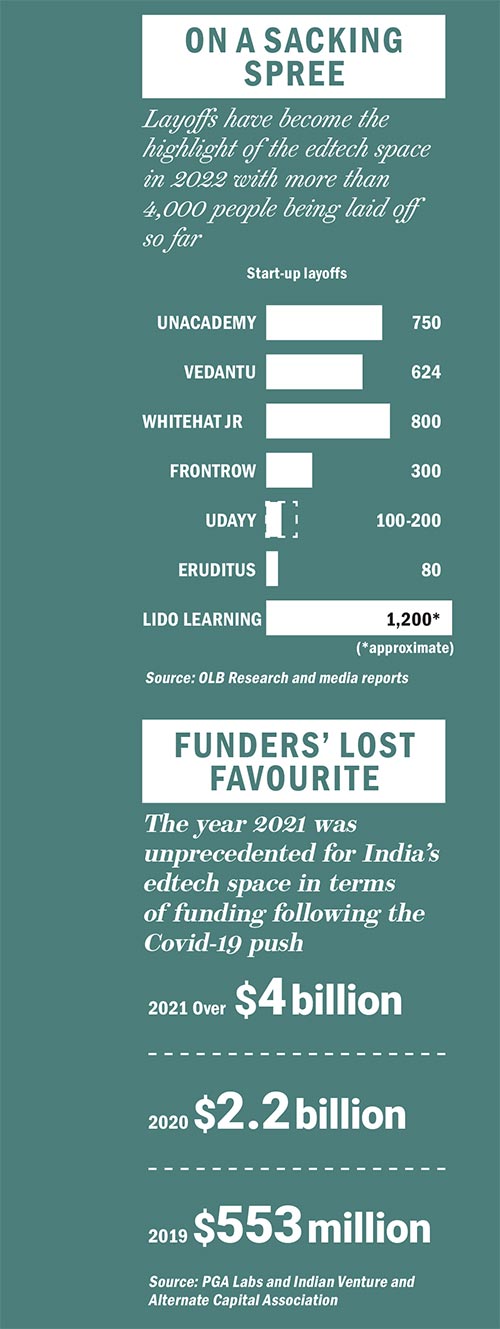When BYJU’s turned a unicorn in 2018, unicorn was not really a buzzword. Today, India has more than 100 unicorns and seven of them, including BYJU’s, are edtechs. Unacademy achieved the cult status in 2020, while upGrad, Vedantu and Eruditus reached the $1 billion valuation mark in 2021. In 2022, LEAD became a unicorn in January and PhysicsWallah joined the club in June.
The year 2021 was unprecedented for India’s edtech space, which saw more than $4 billion being pumped into it. Covid-19 had clearly played a big role in the skyrocketing of the sector, as the funding numbers stood at $553 million in 2019 and $2.22 billion in 2020, according to a report by PGA Labs and Indian Venture and Alternate Capital Association.
Speculations about its size were rife, too. While a Blume Ventures report pegged the edtech market at close to $750 million in 2020, set to hit $4 billion by 2025, a report by market research firm RedSeer puts that number at $5 billion by 2025. A report by RBSA Advisors anticipated that the market size will grow to $30 billion by 2031.
In 2022, however, the game has been turned on its head completely. Edtechs, particularly in the K-12 segment, are struggling to survive amid plunging valuations, fund crunch and layoffs. Even the top ones are trying their best to somehow stay afloat in the current crisis with existing investors unwilling to support any more mindless cash burn.
To keep their heads above water, the edtechs are being forced to go back to the drawing board to come up with alternate delivery models, get their marketing act together, cut their dependence on funds from investors and embark on a road to profitability, failing which, they risk dying a quick death.

Laying it Bare
This year, layoffs have become the highlight of the space, with more than 4,000 people being removed from their jobs in edtech sector so far.
It all started at a virtual town hall meeting in February when Sahil Sheth, founder and CEO of Lido Learning, in front of his 1,000-1,200 employees, announced that the company was closing down due to fund crunch. He also asked the employees to start looking for jobs while promising that their salaries would be paid within 90 days. Since then, several other players have been reportedly trying to acquire Lido.
In early April, Unacademy laid off around 600 employees on account of non-performance and role redundancy. The company, in a statement, said that it was part of a regular appraisal process and re-evaluation. It further fired 150 employees in June. Vedantu followed suit by laying off 624 employees in two rounds of retrenchment. Almost all of those laid off were from the company’s academic teams, working as assistant teachers.
Over 800 employees of BYJU’s-owned WhiteHat Jr resigned after being asked to work from office. Such a large number of employees rendering their resignation, however, does not seem like a regular move. Then, FrontRow let go of 300 of its employees, while unicorn Eruditus laid off 80 of its people. Udayy, a K-12 edtech, shut shop altogether and laid off its entire workforce of 100-120 people.
While Unacademy and Vedantu refused to comment on the layoffs hitting the segment, sources say that some of the educators who were given the pink slip knew about their dropping performance. Unacademy has “intern educators”—small-scale contract-based educators who are onboarded, trained and scaled—who are regularly assessed for their performance. Most layoffs were in this category.
“The skill set required in edtech firms is rapidly evolving, partly due to technology and partly due to the natural progress from a start-up to an enterprise. For the same reason, employees also find themselves doing very different things from what they wanted to do when they joined,” says Narayanan Ramaswamy, national leader, education and skill development, KPMG India, explaining the possible reasons behind the recent layoffs. The pressure from VCs and PEs for results is also something that not many employees can cope with, he adds.
Lure of a Hybrid Model
One of the biggest reasons behind edtechs resorting to cost cutting is the tapering demand for online education, as offline educational institutions and schools have now reopened. To attract students, Vedantu recently launched Ai Live, an interactive platform which brought down its fee structure for a one-year long-term course for grades 6 to 12 from Rs 22,000-25,000 to Rs 5,000.

Pallav Pandey, the co-founder and CEO of Uolo, a B2B edtech company that offers its products through schools, explains why the unaffordability of edtechs is the segment’s biggest challenge. “Products of 70% of the edtechs are priced around Rs 20,000, while 98% of the learners pay less than Rs 30,000 annually as school fees. Most edtechs have failed to crack the distribution model, as reflected in their exorbitant marketing spends and high customer retention cost. In the K-12 segment, the customer acquisition cost varies anywhere between Rs 10,000 and Rs 60,000 per learner for B2C products. This only makes the products costlier for customers,” he says. The high cost of the product, then, forces edtechs to target only high-income customers, ruling out the mass scale option, he adds.
Experts say that the intensity of action in the segment in terms of hiring, investments and new enrolments may come down as offline classes begin to resume. The desperation to stay relevant is evident in edtechs. They are forced to look at a hybrid model and be present both online and offline.
Byju’s acquisition of Aakash Educational Services at a whopping $1 billion was a long-term plan. Aakash has more than 200 brick-and-mortar centres and a student count of 2.5 lakh. It can help BYJU’s reach Tier II and Tier III centres, which the edtech giant has not quite been able to tap into yet. It also announced the launch of BYJU’s Tuition Centre, a comprehensive programme that blends offline and online learning experiences, across 200 cities. The edtech plans to enroll one million students into this programme in the next two years through its 500 centres.
Unacademy, too, went offline by opening its first learning centre in Kota—India’s coaching capital for engineering aspirants. It has reportedly onboarded about 30 top teachers from the city, some even from local favourite Allen Career Institute. More such centres are in the pipeline.
upGrad has forayed into the test preparation market by acquiring GATE Academy which has some 50 centres across India. It has been rebranded as upGrad Jeet and will focus on the Hindi-speaking small-town folks who are looking for mid-level government jobs.
All these examples largely operate in the K-12 space, where all firefighting seems to be happening. UpGrad chairman Ronnie Screwvala knows why. “It is incorrect to say that edtech boomed during the pandemic. It was only the K-12 segment that saw a sudden surge. There were two primary reasons for it—obnoxious valuations of a few K-12 edtechs, leading to heavy cash burn, and parents getting into the FOMO mode for their school-going children and getting them enrolled with these edtechs. With the physical opening of schools, that has changed,” he explains while asserting that non-K-12 segment is still going strong.
Apart from expansion in smaller towns, established edtechs are also taking the acquisition route to consolidate their position in a rough market. BYJU’s, the world’s most valued start-up, has made 16 major acquisitions since 2017—nine of which were in 2021 alone. Unacademy, India’s second most valued edtech start-up, already has 11 acquisitions under its belt. upGrad, which turned a unicorn last year, has also made about nine acquisitions to consolidate its position in the segment. Even Vedantu had acquired a few start-ups last year.
However, with the giants scaling back in terms of newer rounds of investment, doors may open up for some backbenchers to rise and shine. PhysicsWallah, India’s latest edtech unicorn, being the primary example in this category. India’s only profitable edtech company recently raised $100 million at a time when even the bigger names are struggling to raise money. The company claims to be profitable since FY21 and has acquired over four million users organically.
Course Correction
Experts suggest multiple ways in which the edtech sector can survive the downturn, including cutting down on cash burn by reducing needless marketing exercises, lowering the cost of student acquisition and smart pricing. Rahul Kashyap, co-founder of SkillSlash, an edtech offering upskilling courses and internships for real-time projects, feels the answer lies in staying relevant to the student. “The industry can prevent this downtrend if players move their focus towards value-based learning. In other words, edtech companies offering relevant, immersive and helpful content will continue to thrive. The drop rate of online courses has already reached 96%. In the long run, edtechs will also need to focus on innovative strategies, like gamification, personalisation and bite-sized learning to stay relevant,” he says.
According to a Bain and Company report, in collaboration with Indian Venture and Alternate Capital Association, the number of VC deals is poised to go down this year. In fact, a Crunchbase report found that the global VC funding in February ($52 billion) dropped by $10 billion month-on-month. The early-stage funding and late-stage funding fell by 17% and 19% respectively, the report said.
Whether the future of edtech can still be as it was perceived a couple of years ago is something only time will tell. As of now, the answers to issues of valuation versus actual value, acquisition costs versus profits, return to investors versus educational progress and offline versus online will decide the fate of the sector, and its employees, in the next few years.











 Just one email a week
Just one email a week